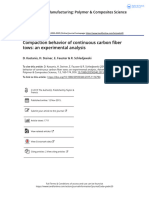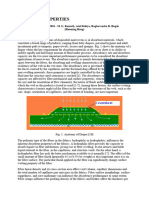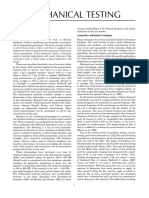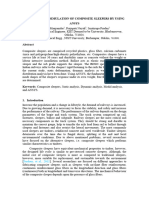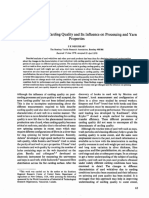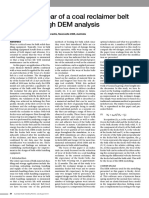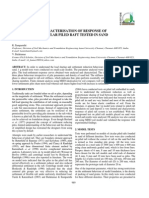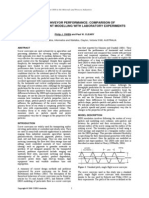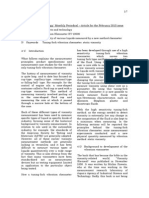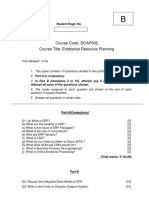Caliper Effects On Density: Wound Roll
Caliper Effects On Density: Wound Roll
Uploaded by
sheng-huang WuCopyright:
Available Formats
Caliper Effects On Density: Wound Roll
Caliper Effects On Density: Wound Roll
Uploaded by
sheng-huang WuOriginal Title
Copyright
Available Formats
Share this document
Did you find this document useful?
Is this content inappropriate?
Copyright:
Available Formats
Caliper Effects On Density: Wound Roll
Caliper Effects On Density: Wound Roll
Uploaded by
sheng-huang WuCopyright:
Available Formats
Winding-
Caliper effects on wound roll density
Scott A. Baum and David R. Roisum
In two tria& a new analyzer for roll densip showed that an erratic response
was attributable to thepaper caliper instead of any problem with the winder.
The roll density analyzer has proven to be a useful tool
1. The configuration for the conventional density analyzer equipment
for winding diagnostics. It is automated and easy to use, is shown in solid lines, and the option for correcting caliper is shown
and it is highly sensitive to changes in the wound roll. One in Dhantom.
limitation has been that density analyzers have been too
sensitive to changes in web caliper, making it difficult to Con chuck
determine if fluctuations in the density profile were Counter
reflecting changes in winding or web caliper, or both. timer board
Consequently, a new density analyzer has been developed
to incorporate measurements of web caliper.
Development of the density analyzer
I
Properties that have been monitored for quality control L . 1
for decades are basis weight, caliper, and web density in
an unloaded condition. Low densities of less than 0.01 lb/
in.5 are desired for tissue and toweling in which bulk (the connected to an LVDT (linear variable displacement
inverse of density) and absorbency are important.
transducer) for measuring radial deformation as addition-
Conversely, high densities of more than 0.042 lb/in.3 are
al layers were added during winding (1).However, this
typical for lightweight coated grades in which the sheet
crude device gave density only at a single data point as
is filled with clays and other materials to provide a dense
a function of added wraps and was not suitable for
and smooth printing surface.
production measurements.
Density can be calculated from basis weight and caliper
In the 1970s, the term “density)’ began to appear as
as:
synonymous with “wound-in-tension))in literature about
p = b/c (1) winding. This usage appeared in an article in 1970 by
Shvetsov, who compared the density of wound rolls to the
where unstressed density of the parent material (2).He defined
a density index as:
p = density, kg/m3 (lb/in.a)
b = basis weight, or grammage, kg/m2 (Ib/in.*) density index = p/po (2)
c = caliper, m (in,). where
p = rewound roll density, kg/m3 (lb/in.3)
Long before the density analyzer instrument was PO = unstressed material density, kg/m3 (lb/in.3).
invented, the density of a web material was found to
increase with increasing z-direction loading. In particular, Shvetsov found this density ratio to vary from 0.80 to
high wound-in tensions produced high interlayer pres- 1.09 for more than 600 rolls of paper tested from several
sures and, consequently, an increase in density that could mills and proposed this measure be used for roll quality
be discerned with careful measurements of roll diameter control. A similar approach is used to estimate the amount
and weight. In 1967, Ul’yanov patented a density meter of air wound into rolls of impermeable material such as
consisting of a tab inserted between layers of the roll and plastic film. In 1979, Hewinson obtained a US. patent for
a winding machine design that was claimed to control
wound roll density at a predetermined value by winding
Baum is research and development engineer, Beloit inside a loop of belt that controlled the circumference of
Corp. Research Center, 1165 Prairie Hill Rd., Rockton, the rewinding roll (3).
111. 61072-1595. Roisum is senior research scientist, However, it was not until 1980 that the first practical
Kimberly-Clark Corp., 2100 Winchester Dr., Neenah, measurement method for density became available, with
Wis. 54956 the invention of a computerized roll density analyzer. This
July 1991 Tappi Journal 123
development was headed by Eriksson of the Swedish 2. Noncontactingpneumatic servo c&ipor gauge
Newsprint Research Center and was funded by a
consortium of three corporations (4-6). Since then, many
machinery builders and paper companies have developed
~
similar instruments. Today, there are many different Connector
kinds of density analyzers in use on paper mill reels, LVDT
winders, rewinders, and unwinds throughout the world.
Some of these density analyzers are based on portable
personal computers, while others a r e permanently
mounted in benchboards or control cabinets.
While the density analyzer may not be the most common
method of measuring roll structure, its performance is by Reference chamber
far the best documented in the pertinent literature. Control chamber
Eriksson showed the effect of torque, nip, and tension on
wound-in density, the relationship between wound-in and
wound-off density of the roll after long-term storage, and
the effect of wrap sample size (4-6). McDonald showed the
correlation between roll hardness and density, the effect Nozzle
of calendering (caliper) on density, and the effect of torque
on density (7). Odell’s study was the most complete,
detailing the effects of the paper machine, the effects of Work piece
torque, nip pressure, tension, speed, and acceleration, the
Reference
effect of splices, and the effect of the winder set location
on the parent reel to the density profile at the winder (8).
Similar studies were performed by others (9-12).
The density analyzer is popular because it has most of
the attributes of an ideal roll structure measurement system
(13). These attributes include profiling with respect to
diameter for setting up programs for torque, nip pressure,
and winding tension. Furthermore, the analyzer has
recording capabilities, it performs nondestructive testing,
it is easy to use, and its cost is moderate. Perhaps the two
greatest advantages are that it has relatively high resolution
of changes in roll structure and that it can be implemented the roller encoder, and the diameter of the wound roll can
for automated on-line production measurements. be calculated from the ratio of the pulses of the roll and
However, since its invention, most of the improvements roller encoders. These measurements are used to calculate
in the density analyzer have been enhancements rather density (4-7, 14) using Eq. 3:
than fundamental changes in design. Previous improve-
ments have included faster computers, higher count p = (26 n2ppr) / [d (pi - pi-l)l (3)
encoders, and a better coupling of encoders to the rotating
roll and roller. Caliper cross-sensitivity has been recog- where
nized as a problem (7, 8), but its detrimental effects on p = roll density, kg/m3 (lb/h3)
instrument utility have not been dealt with until recently.
Because the early density analyzers were undesirably b = basis weight, kg/m2 (lb/in.2)
sensitive to changes in web caliper, it was not easy to n = roll rotation per sample, revolutions
determine if fluctuations in the density profile reflected
changes in winding or in web caliper, or both. p p r = roller encoder pulses per revolution
Consequently, a new density analyzer has now been d = roller diameter, m (in.)
developed that supplements the roll diameter and footage
pi = roller encoder pulses for sample i
measurements with web caliper measurements. Now the
changes in the wound roll can be distinguished as to the pi-l = roller encoder pulses for sample i - 1.
caliper effects and the roll structure effects caused by the
winder. Additionally, this redesign of the density analyzer All of the terms in Eq. 3 can be measured with extreme
has improved the measurement sensitivity. accuracy except one, the basis weight 6. Previously, the
basis weight was assumed to be constant, but it actually
varies as a result of fluctuations in web manufacturing.
Principle of operation Thus, there was no method for separating web effects (b)
Figure 1 shows the original configuration of the density from winding effects (pi - pi-& Consequently, it was risky
analyzer. It consists of a winding or unwinding roll, a roller to diagnose a problem as to its source.
traveling a t web speed, incremental rotary encoders One approach to determining basis weight for Eq. 3
attached to the axes of the roll and the roller, pulse might be to use information from the basis weight
counters, and a microcomputer. The length of web wound scanners on the paper machine. However, there is no
into a roll can be calculated from counting pulses from mechanism for “aligning” basis weight data to winder
124 July 1991 Tappi Journal
3. Diameter vs. caliper, conventional density, and-caliper-corrected
The nozzle is designed such that the back pressure,
density for copy paper calendered with the stack loading decreased developed by the discharging supply air, varies with the
stepwise gap between the sensing orifice and paper web. This back
pressure controls the servo mechanism, maintaining a
4.5 I 1 gap of 0.003 in. between the nozzle and paper. Thus,
changes in the caliper of the paper cause the nozzle to
displace accordingly.
Mechanical displacement of the nozzle sensed by the
LVDT is converted to a proportional voltage by signal
conditioning of the output. Frequency response is rated
I at 30 Hz for amplitude variations up to 0.004 in. The gauge
2.5
0 10 20 30 can resolve displacements as little as 5 x in. at a
0.045 1 1
frequency response up to 30 Hz.
Caliper information from two gauges is monitored by
the density program using an analog interface circuit
board, as Fig. 1 shows. The program and signal condi-
tioning units are designed for processing the displacement
of each gauge head separately or the average of both gauge
heads. Web caliper is sampled at a rate of 18 Hz, and the
0.025 I 1 average during the sample period is used for density
0 10 20 30
calculations to compensate for caliper variations, which
affect the diameter change of a winding roll.
-
Gauge calibration is performed using a precision feeler
gauge. However, because the web beneath the sensing
-. head is under loading from both web tension and nozzle
pressure, the readings may need to be corrected to an
unloaded condition, which for linear elastic materials is:
0 10 20 30
DIAMETER
where
UR = , loading induced by nozzle pressure, kg/m2 (lb/in.2)
density samples to the required accuracy of a couple of
feet, Since it is prohibitively expensive to equip winders m = stress induced by web tension, kg/m2 (Ib/in.2)
with their own basis weight scanners, this approach was ER = roll radial modulus ( z direction for the paper), kg/m2
not a practical alternative. (Ib/in.2)
We find an alternative approach in Eq. 1,which shows
us that density, basis weight, and caliper are coupled. ER = roll tangential modulus (machine direction for the
Thus, it might be more economical to obtain the caliper paper), kg/m2 (Ib/h2)
than to measure basis weight. Combining Eqs. 1 and 3 MT = Poisson ratio.
yields a caliper-corrected density formulation:
Corrections for highly nonlinear materials require
P =( 2 ~ ‘ ~P P T/) [d (Pi - ~ i - d l (4) “backing down” the stress-strain curve. The magnitude
where of the correction depends on the x-direction stiffness of the
grade and can be from as little as 1%for paperboard grades
po = mean unstressed density of the material measured in to more than 10%for bulky grades.
the test lab.
Benefits of caliper corrected density
Using this equation, we can measure web fluctuations
through changes in caliper. The result is an improvement For the purpose of discerning the effect of caliper
in performance. Changes in density in unstressed material variations on the monitoring of wound roll density, tests
are relatively small in comparison to changes in basis were run on two rolls manufactured with severe caliper
weight or caliper for web materials such as paper. (Density gradients. Each roll was a 47-1b/3000 f t 2 basis weight copy
changes are essentially independent of basis weight or paper calendered on Beloit Research’s pilot calender.
caliper for other web materials such as films and foils.) The calender nip pressure for each roll was adjusted
to give a desired test caliper profile. Roll A was calendered
On-line caliper measurement using three different nip pressures decreased stepwise,
which resulted in the staircase caliper profile shown in
On-line determinations of paper caliper were made using the top graph of Fig. 3.Roll B was calendered with a ramp
a noncontacting pneumatic servo gauge head. As Fig. 2 function first increasing and then decreasing and then
shows, the gauge uses a pneumatic servo follower nozzle increasing for stack loading. The resulting caliper profile
connected to a LVDT displacement transducer. is shown in Fig. 4 in the top graph. After calendering,
July 1991 Tappi Journal 125
the rolls were wound on the pilot winder for both 4. Diameter vs. caliper, conventional density, and caliper-corrected
conventional and caliper-corrected determinations of roll density for copy paper calendered with the stack loading increased
density. Because paper caliper was the variable of interest, and decreased gradually
the rolls were wound with constant torque (55% front
4.5 1 1
drum), nip pressure (5 pli), and tension (2 pli).
The conventional density readings for the stair-stepped
Roll A is shown in the center graph of Fig. 3. As shown,
the conventional density profile mirrors the caliper of the
incoming sheet. In other words, low caliper yields high
density, and vice-versa. However, the shape of the caliper
profile is not known for conventional density. Thus, one 2.5
might be tempted to conclude that something was amiss 0 10 20 30 40
with the winding of the roll, when in fact the erratic
response was almost entirely due to the paper. By contrast,
the caliper-corrected density shown in the bottom graph
of Fig. 3 yields a nearly uniform profile, eliminating all
of the density offsets produced by the more uniform paper
caliper from programming of the winder for the constant
torque, nip pressure, and tension profiles.
Similarly, the conventional density profile for the 0.025 I I
0 10 20 30 40
ramped Roll B given in Fig. 4 (center) mirrors its incoming
caliper profile. Again, without the caliper-corrected density
E 0.045
I- -.
profile given in Fig. 4 (top), one might be tempted to adjust ti=
K c3 0.040
winding profiles to compensate for a problem that has its a
source in the web. With caliper measurement, however, &5 0.035
we can distinguish web problems from winder problems. &Z
2 5 0.030
io
Radial compression a
u 0.025
Admittedly, the two examples are somewhat artificial 0 10 20 30 40
because real web caliper profiles are not as exaggerated. DtAMETER
Therefore, let us take a third example, in which caliper
profiles are as obtained from a mill. Additionally, we will
use this example to illustrate an alternative approach to
caliper-corrected density. This measure is termed “radial yields a fine profile of over 1000 data points for a roll of
compression” and is calculated as: typical size.
Though radial compression and caliper-corrected
Radial compression, % = 100%x [2nCi - (Di- Di-1)1/(2 n a) (6) density profiles have the same shape and measurement
In this expression, the term 2 n c is the expected diameter resolution as in the bottom graph in Fig. 5, the radial
increase of the winding roll if the web were wound without compression profile has several potential advantages.
stress, which is simply twice the current caliper times the These include:
number of wraps per sample. The term Di - Di-I is the 1. All inputs to the equation are measured by the
measured diameter change during a sample period. The instrument, whereas the density approach requires an
numerator is the difference between the expected input of basis weight (or unstressed density) from lab
diameter increase and the measured diameter increase. testing.
If the roll is wound at a high tension, it will not grow as 2. Radial compression is a simpler calculation.
quickly as at a low tension because the z-direction pressure 3. Radial compression is zero for a zero wound-in tension.
decreases the thickness of the web inside the roll.
The top graph of Fig. 5 shows a caliper profile for an 4. Radial compression yields values in more self-evident
NCR paper of 31 lb/3000 ft2 that was sent to Beloit units (% vs. kg/m2).
Research for customer trails. For measuring the resolution 5. Radial compression is a fundamental roll structure
of the new instrument, the roll was wound with a sharp measurement closely related to radial strain.
stepwise drop in tension from 4 pli to 1 pli at a diameter
of 20 in. As the center graph of Fig. 5 shows, the resulting Conclusions
density profile does indeed exhibit the expected drop in
roll structure at 20 in. even without caliper information In conventional density analyzers, basis weight is assumed
(which was used in the equation as a constant). However, to be constant for the calculations, despite the fact that
if the measured on-line caliper is used in the calculation, basis weight varies considerably for the manufacture of
the winding profile stands out more clearly (bottom graph, real webs. If the density principle is extended to also
Fig. 5). Indeed, the resolution of the instrument has measure caliper, several advantages are realized. First,
increased for real web winding by more than an order it is possible to distinguish web problems from winding
of magnitude if caliper information is used. Thus, it is not problems, which aids in diagnostics. Second, with caliper
unusual to obtain wrap counts smaller than 20, which correction, the noise of the density profiles decreases, so
126 July 1991 Tappi Journal
5. Diameter vs. caliper, conventional density, and both radial 6. Eriksson, L. G., Lydig, C., Viglund, J. K., and Komulainen,
compression and caliper-correcteddensity for the NCR paper P., Svensk Papperstid. (4):86(1983).
7. McDonald, J. D. and Farrell, W. R., Pulp Paper Can. 86(9):
56(1985).
8. Odell, M. H., Symons, R. E., and Brown, G. S., APPITA 38(5):
359(1985).
9. Granlund, B., Proceedings of the First Winding Technology
Conference, Swedish Newsprint Research Center (TFL),
Djursholm, 1987, p. 167.
10. Komulainen, P., 1982 Paper Finishing and Converting
Conference Proceedings, TAPPI PRESS, Atlanta, p. 87.
2.6l . ’ 11. Komulainen, P. and Tulkki, M. ATIP Review 37(8):434(1983)
0 10 20 30 40 (in French).
12. Holmer, H., Larsson, P., Svahn, T., Westman, L., and Warner,
M., Changes in reel-density curves induced by different
winding parameters, Advances and Trends in Winding
Technology, Proceedings of the First Winding Technology
2 2
5 0.026 Conference, Swedish Newsprint Research Center (TFL),
Djursholm, 1987, p. 153.
8 0.024
I
13. Roisum, D. R., Tappi J. 71(10): 91(1988).
14. Roisum, D. R., The measurement of web stresses during roll
ap 0.022b . 10
’ 20 30 40 winding, Ph.D. thesis, Oklahoma State University, May 1990.
Received for review Sept. 6, 1990.
Accepted Dec. 12,1990.
s
i DIAMETER
that the statistical significance of diagnostics measur(
ments improves. Third, the noise reduction allows us 1
obtain wound roll structure profiles with a much fine
spatial resolution than ever before. Finally, the alternativ
measure of radial compression, which is obtained fro1
exactly the same measurements as caliper-corrected
density, holds promise for a more meaningful measure of
wound roll structure.
The principles used in these extensions to the density
approach have been carried through from laboratory
prototype to portable field analyzers. The result is a
portable personal computer hardware package with
menu-driven software than can be set up quickly on most
reels, winders, and unwinds. Consequently, one unit can
be used for many winding machines. Furthermore, the
system is designed for completely unobtrusive and
automated data acquisition. Finally, the instrument leaves
us with little reason not to monitor roll structure quality.0
Literature cited
1. Ul’yanov, V. I., Tensometric apparatus for the control of web
winding, U.S.S.R. Patent 249,929 (Nov. 30, 1967).
2. Shvetsov, Y. N., Bumazh. Prom. (6): 21(1970) (Russian).
3. Hewinson, V. K., Barlow, R., and Fogarty, E., Method and
apparatus for forming a fibrous cylindrical element, U.S.
Patent 4,146,188 (March 27,1979).
4. Eriksson, L. G., Lydig, C., Viglund, J. K., and Komulainen,
P., Measurement of paper roll density distribution, report to
the Swedish Newsprint Center (TFL), Djursholm, Sweden.
5. Eriksson, L. G., Lydig, C., Viglund, J. K., and Komulainen,
P., Tappi J. 66(1): 63(1983).
July 1991 Tappi Journal 127
You might also like
- Improved FE Through Image-Derived Density - SPWLA-2003Document14 pagesImproved FE Through Image-Derived Density - SPWLA-2003Shahriar ShahbazianNo ratings yet
- Compaction Behavior of Continuous Carbon Fiber Tows An Experimental AnalysisDocument7 pagesCompaction Behavior of Continuous Carbon Fiber Tows An Experimental Analysisenkilee2020No ratings yet
- D. ILIC Australia - Measurement and Simulation of The Bulk Solid Load On A Conveyor BeltDocument13 pagesD. ILIC Australia - Measurement and Simulation of The Bulk Solid Load On A Conveyor BeltJonathan PérezNo ratings yet
- Predicting Traction in Web Handling: K. S. Ducotey J. K. GoodDocument7 pagesPredicting Traction in Web Handling: K. S. Ducotey J. K. GoodEsteban CorderoNo ratings yet
- Bulk Material ScienceDocument6 pagesBulk Material ScienceDavidNo ratings yet
- Absorption PROPERTIESDocument5 pagesAbsorption PROPERTIESfelixkurumsalNo ratings yet
- Bulk Material ScienceDocument6 pagesBulk Material ScienceAndresNo ratings yet
- Science Raking in Gravity Thickeners PDFDocument17 pagesScience Raking in Gravity Thickeners PDFJuan Alberto Giglio FernándezNo ratings yet
- N. V. V. Mason: K. SaatjianDocument12 pagesN. V. V. Mason: K. SaatjianaowsNo ratings yet
- A Novel Cased-Hole Density-Neutron Log Interpretation and CharacteristicsDocument7 pagesA Novel Cased-Hole Density-Neutron Log Interpretation and CharacteristicsCAlexPereiraNo ratings yet
- Features: Fabric Drape & Its MeasurementDocument8 pagesFeatures: Fabric Drape & Its MeasurementSubrata MahapatraNo ratings yet
- Hardness TestingDocument8 pagesHardness TestingengkankwNo ratings yet
- Donecker (2011) - Dynamic Scale Modelling (DSM) of Transfer ChutesDocument6 pagesDonecker (2011) - Dynamic Scale Modelling (DSM) of Transfer ChutesDilson TavaresNo ratings yet
- Anewlightweightpenetromenter AgjDocument11 pagesAnewlightweightpenetromenter AgjMonirul Islam BadalNo ratings yet
- Composite Sleepers - ConferenceDocument7 pagesComposite Sleepers - Conferencesmitirupa.pradhanfmeNo ratings yet
- MTS Hardness and Modulus PaperDocument18 pagesMTS Hardness and Modulus PaperHesbon MoriasiNo ratings yet
- Density Log Dexter Tanabe 20000241Document15 pagesDensity Log Dexter Tanabe 20000241Dexter TanabeNo ratings yet
- Investigation and Comparison of 24 GHZ Wearable AnDocument11 pagesInvestigation and Comparison of 24 GHZ Wearable AnMirela CimpanuNo ratings yet
- B.M.S College of Engineering Autonomous Institute, Affiliated To VTUDocument24 pagesB.M.S College of Engineering Autonomous Institute, Affiliated To VTUchaithanyap.ctm23No ratings yet
- 3d-Electronic Fabric QualityDocument10 pages3d-Electronic Fabric QualityRamin AbghariNo ratings yet
- 2018 - Nguyen - Evaluation of Multiplier Coefficients For A Pile Group Under Seismic Loading in Dry Loose SandDocument8 pages2018 - Nguyen - Evaluation of Multiplier Coefficients For A Pile Group Under Seismic Loading in Dry Loose SandBảo Ngọc NguyễnNo ratings yet
- 10 1016@j Ces 2019 06 046Document15 pages10 1016@j Ces 2019 06 046Мила ГетоваNo ratings yet
- Handle Properties of FabricDocument100 pagesHandle Properties of FabricVasant Kothari67% (3)
- Pressuremeter Tests in Municipal Solid Waste Measurement of Shear Stiffness - DixonDocument14 pagesPressuremeter Tests in Municipal Solid Waste Measurement of Shear Stiffness - DixonSen HuNo ratings yet
- Bubble Size and Velocity Measurement in Gas-Liquid Systems: Application Fiber Optic Technique To Pilot Plant ScaleDocument5 pagesBubble Size and Velocity Measurement in Gas-Liquid Systems: Application Fiber Optic Technique To Pilot Plant ScaleAmin SmileyNo ratings yet
- Jresv20n2p241 A1bDocument15 pagesJresv20n2p241 A1bTaha AbdouNo ratings yet
- Journal of The Air Pollution Control AssociationDocument6 pagesJournal of The Air Pollution Control Associationavisek_misrNo ratings yet
- Dynamic Scale Modelling of Transfer Chut 2Document12 pagesDynamic Scale Modelling of Transfer Chut 2Soubhagya Ranjan PatnaikNo ratings yet
- Detailed Analysis of Carding Quality and Its Influence On Processing and Yarn PropertiesDocument8 pagesDetailed Analysis of Carding Quality and Its Influence On Processing and Yarn Propertiesരജീഷ് വി എംNo ratings yet
- Original Paper/: Characterization of Melt Blown Web Properties Using Air Flow TechniqueDocument8 pagesOriginal Paper/: Characterization of Melt Blown Web Properties Using Air Flow TechniquealbertoNo ratings yet
- Flow and Turbulence Characteristics of Open Channel Flow Over A Mobile BedDocument5 pagesFlow and Turbulence Characteristics of Open Channel Flow Over A Mobile BedprashanthreddyhNo ratings yet
- Uryadov DEM Vibratory Conveyors FinalDocument11 pagesUryadov DEM Vibratory Conveyors FinalSupattarachai SudsawatNo ratings yet
- Sensors 15 24318Document25 pagesSensors 15 24318skalanidhiNo ratings yet
- Analysis of The Pipe Conveyor Belt Pressure On The Rollers On Its CircuitDocument16 pagesAnalysis of The Pipe Conveyor Belt Pressure On The Rollers On Its CircuitFenglin YAONo ratings yet
- Experimental Observations and Parametric Study of Piled Raft Foundation Using PlaxisDocument7 pagesExperimental Observations and Parametric Study of Piled Raft Foundation Using PlaxisAngelinSavioNo ratings yet
- Horizontal Saddle Supported Storage Vessels: A Parametric Study of Plastic Collapse LoadsDocument27 pagesHorizontal Saddle Supported Storage Vessels: A Parametric Study of Plastic Collapse LoadsBimaNo ratings yet
- Shape Optimization of A 3D Slider With DimplesDocument9 pagesShape Optimization of A 3D Slider With DimplesTarang MalvaniyaNo ratings yet
- 1 s2.0 S0378437116305982 MainDocument17 pages1 s2.0 S0378437116305982 Mainkingofmonsters99999No ratings yet
- Prediction of Fabric Compressive Properties Using Artificial Neural NetworksDocument13 pagesPrediction of Fabric Compressive Properties Using Artificial Neural NetworksGurumurthy RamaiahNo ratings yet
- Reducing Wear of A Coal Reclaimer Belt Feeder Through DEM AnalysisDocument5 pagesReducing Wear of A Coal Reclaimer Belt Feeder Through DEM AnalysisBin ChenNo ratings yet
- 1968 Cochrane PDFDocument9 pages1968 Cochrane PDFศิวาเวช อบมาNo ratings yet
- 1968 Cochrane PDFDocument9 pages1968 Cochrane PDFRanjithNo ratings yet
- Wear Measuring and Wear Modelling Based On Archard, ASTM, and Neural Network ModelsDocument8 pagesWear Measuring and Wear Modelling Based On Archard, ASTM, and Neural Network ModelsPacifier NothingfaceNo ratings yet
- O F F P I R C E I P A R L I N T: The Effect of Machine Conditions and Furnish Properties On Paper CD Shrinkage ProfileDocument24 pagesO F F P I R C E I P A R L I N T: The Effect of Machine Conditions and Furnish Properties On Paper CD Shrinkage ProfileDebanjana ChowdhuryNo ratings yet
- Textile Progress: Worsted SpinningDocument3 pagesTextile Progress: Worsted SpinningSagarika AdityaNo ratings yet
- Iccste 205Document8 pagesIccste 205Htoo Myat AungNo ratings yet
- 1988 - The In-Situ Measurement of The Undrained Shear Strength of Clays Using The Field VaneDocument33 pages1988 - The In-Situ Measurement of The Undrained Shear Strength of Clays Using The Field VaneDaniel Mejia LoeraNo ratings yet
- Determination of Loop Length, Tightness Factor and Porosity of Single Jersey Knitted Fabric PDFDocument7 pagesDetermination of Loop Length, Tightness Factor and Porosity of Single Jersey Knitted Fabric PDFNasrin AkterNo ratings yet
- 0 Artificial Neural Network Application For Flexible Pavement Thickness ModelingDocument6 pages0 Artificial Neural Network Application For Flexible Pavement Thickness ModelingPatricioNo ratings yet
- Characterisation of Response of Circular Piled Raft Tested in SandDocument7 pagesCharacterisation of Response of Circular Piled Raft Tested in SandVenkatraman BalakumarNo ratings yet
- Screw ConveyorDocument7 pagesScrew Conveyorjdsheth2004100% (1)
- Integration of Gyratory CrusherDocument8 pagesIntegration of Gyratory Crusherrolandoh1No ratings yet
- Design of Mist Eliminators PDFDocument8 pagesDesign of Mist Eliminators PDFVijay KaleNo ratings yet
- This Chapter Includes The Following Characteristics:: Chapter 2. Properties and Characterization of Thin FilmsDocument13 pagesThis Chapter Includes The Following Characteristics:: Chapter 2. Properties and Characterization of Thin FilmsFaijan KhanNo ratings yet
- SPE 59698 Advances in Deep-Penetration Density LoggingDocument6 pagesSPE 59698 Advances in Deep-Penetration Density LoggingcmkohNo ratings yet
- RheometerDocument7 pagesRheometerAl Alawi PanggabeanNo ratings yet
- Measurement of Overflow Density in Spiral Classifiers Using A Vibrating Fork Densitometer With Accuracy EvaluationDocument8 pagesMeasurement of Overflow Density in Spiral Classifiers Using A Vibrating Fork Densitometer With Accuracy EvaluationClyde SuerteNo ratings yet
- Effect of Cotton Yarn Imperfection Index On CSPDocument4 pagesEffect of Cotton Yarn Imperfection Index On CSPInternational Journal of Innovative Science and Research TechnologyNo ratings yet
- Das 2016Document8 pagesDas 2016Jose SilvaNo ratings yet
- NDT Treasures From The Past: Six Novel Technical Articles Spanning Four Decades of Industrial RadiographyFrom EverandNDT Treasures From The Past: Six Novel Technical Articles Spanning Four Decades of Industrial RadiographyNo ratings yet
- Winding Machines Mechanics and Measureme PDFDocument6 pagesWinding Machines Mechanics and Measureme PDFsheng-huang Wu0% (2)
- Mesh Antennas With Reduced Size: July 2004Document5 pagesMesh Antennas With Reduced Size: July 2004sheng-huang WuNo ratings yet
- Fixed-Order H Infty Tension Control in The UnwindiDocument9 pagesFixed-Order H Infty Tension Control in The Unwindisheng-huang WuNo ratings yet
- Robtrwture Dculations at Constant Wound4.n Tension: AlvinDocument5 pagesRobtrwture Dculations at Constant Wound4.n Tension: Alvinsheng-huang WuNo ratings yet
- An Overview of 3D Printing Technologies For Food FabricationDocument11 pagesAn Overview of 3D Printing Technologies For Food Fabricationpostasului54No ratings yet
- Version Control SystemDocument4 pagesVersion Control SystembharathimanianNo ratings yet
- Satellite HandbookDocument145 pagesSatellite Handbookwalelwi100% (6)
- Manual FlycontrolDocument29 pagesManual FlycontrolMiguel SalazarNo ratings yet
- Math 1040 Skittles Term ProjectDocument4 pagesMath 1040 Skittles Term Projectapi-253137548No ratings yet
- Third Party Assessment FormDocument11 pagesThird Party Assessment Formadityabharat2011No ratings yet
- Fin Irjmets1686210967Document4 pagesFin Irjmets1686210967Yemar MekuantNo ratings yet
- S.D.marasinghe Training ReportDocument34 pagesS.D.marasinghe Training Reportprasaddarshana27No ratings yet
- EXAMPLE 1: Consider The AGVS Layout in Figure - Vehicles Travel Counterclockwise AroundDocument12 pagesEXAMPLE 1: Consider The AGVS Layout in Figure - Vehicles Travel Counterclockwise AroundQuỳnh Nguyễn100% (1)
- Helping Hand - An Advance Way To Communicate With An Orphanage OrganizationDocument3 pagesHelping Hand - An Advance Way To Communicate With An Orphanage OrganizationInternational Journal of Innovative Science and Research TechnologyNo ratings yet
- UHFReader Demo Software User's Guidev1Document17 pagesUHFReader Demo Software User's Guidev1Carlo Grant YuNo ratings yet
- Maxima by Example: Ch.9: Bigfloats and Arbitrary Precision QuadratureDocument33 pagesMaxima by Example: Ch.9: Bigfloats and Arbitrary Precision Quadratureprakush_prakushNo ratings yet
- Jiwaji University Course Work Exam DateDocument4 pagesJiwaji University Course Work Exam Datetvanfdifg100% (2)
- Instructional Materials PreparationDocument31 pagesInstructional Materials PreparationJuhaira DatuwataNo ratings yet
- TT QuickStart v2 A4 PDFDocument4 pagesTT QuickStart v2 A4 PDFQwertyNo ratings yet
- A Survey On Mobile Edge Computing: The Communication PerspectiveDocument47 pagesA Survey On Mobile Edge Computing: The Communication PerspectiveBaban ManhajNo ratings yet
- AMDsl 0309 enDocument856 pagesAMDsl 0309 enLuis Sergio SchwenkeNo ratings yet
- Dcap302 1Document2 pagesDcap302 1Saurav KumarNo ratings yet
- Round 1 AssessmeDocument7 pagesRound 1 Assessmelokesh guptaNo ratings yet
- Computer Applications Class - 10: St. Francis School, VadakkencherryDocument3 pagesComputer Applications Class - 10: St. Francis School, VadakkencherryAyush SinghNo ratings yet
- Chuong 3-Mo Hinh Hoa Quy Trinh Nghiep Vu-1Document96 pagesChuong 3-Mo Hinh Hoa Quy Trinh Nghiep Vu-1Tuyến Lê Thị MỹNo ratings yet
- DATAKOM DKG519 DatasheetDocument2 pagesDATAKOM DKG519 DatasheetDanh TrầnNo ratings yet
- Leonarddorschnerresume 010622Document1 pageLeonarddorschnerresume 010622api-357539175No ratings yet
- C-7 5010 UpdatesDocument39 pagesC-7 5010 UpdatesSalim AlharthyNo ratings yet
- Figure 1two Parse Trees For 9-5+2Document3 pagesFigure 1two Parse Trees For 9-5+2Amal AhmadNo ratings yet
- 04.laboratory Exercise IVDocument5 pages04.laboratory Exercise IVDheerajGunwant80% (5)
- Rust Concurrency CookbookDocument212 pagesRust Concurrency CookbookvenkatnethaNo ratings yet
- Mimaki Engineering Co., LTDDocument148 pagesMimaki Engineering Co., LTDAdrián Eduardo Niebles RodríguezNo ratings yet
- A Circuit For All Seasons - Switched Capacitor IntegratorDocument3 pagesA Circuit For All Seasons - Switched Capacitor IntegratornsitdelhiNo ratings yet
- SAP PLM Integration For NX 4.6 - User GuideDocument46 pagesSAP PLM Integration For NX 4.6 - User Guidekareem shaikNo ratings yet

